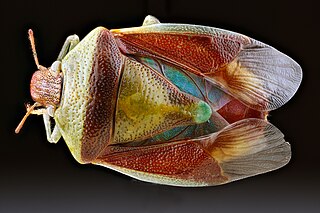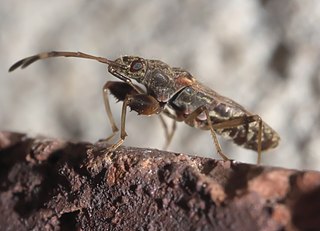
Alydidae, commonly known as broad-headed bugs, is a family of true bugs very similar to the closely related Coreidae. There are at least 60 genera and 300 species altogether. Distributed in the temperate and warmer regions of the Earth, most are tropical and subtropical animals; for example Europe has a mere 10 species, and only 2 of these occur outside the Mediterranean region.

The Harpactorinae are a large subfamily of the Reduviidae. About 300 genera and 2,000 species worldwide have been described. Some of the species of the genera Zelus, Pselliopus, Sinea, and Apiomerus are of interest as biological pest control agents.

Sphedanolestes is a large genus of assassin bugs in the family (Reduviidae), subfamily Harpactorinae. There are more than 190 described species, which are found in southern Europe, Africa and Asia.

Harpactor is a genus of assassin bug family (Reduviidae), in the subfamily Harpactorinae.

Cercopidae are the largest family of Cercopoidea, a xylem-feeding insect group, commonly called froghoppers or spittlebugs. They belong to the hemipteran suborder Auchenorrhyncha.

Euagoras is a genus of assassin bugs, in the subfamily Harpactorinae. Species are found in Asia and Australia.

Dysdercus is a widespread genus of true bugs in the family Pyrrhocoridae; a number of species attacking cotton bolls may be called "cotton stainers".

Edessa is a large New World genus of stink bugs in the family Pentatomidae, containing over 250 described species. Several other genera used to be included until recently, such as Ascra, Paraedessa, Doesburgedessa and others.

Coranus is a genus of assassin bugs in the tribe Harpactorini.

Banasa is a genus of plant feeding stink bugs in the family Pentatomidae.

Halyomorpha is a genus of insects in the family Pentatomidae.

Neopamera is a genus of dirt-colored seed bugs in the family Rhyparochromidae. There are about 16 described species in Neopamera.

Chinavia is a genus of green stink bugs in the family Pentatomidae. There are more than 30 described species in Chinavia.

Tessaratoma is a genus of bugs in the family Tessaratomidae. There are more than 20 described species in Tessaratoma.

Pristhesancus is a genus of insects in the family Reduviidae, the assassin bugs. Species have been recorded from Australia and certain Pacific Islands.

Ectinoderus is a genus of Asian bugs in the family Reduviidae. It is the type genus of the tribe Ectinoderini: the 'Oriental resin bugs'.

The Micrelytrinae are a subfamily of bugs in the family Alydidae, based on the type genus Micrelytra Laporte, 1833. Genera are recorded from the Americas, Europe and Asia.

Monalonion is a genus of bugs in the family Miridae and tribe Dicyphini.

Epidaus is a genus of assassin bugs with about 25 species mainly distributed mainly in the Oriental Realm with two species which extend into the Palearctic Realm. Most species have a long and narrow body with the pronotum having a posterior margin with raised corners and spiny outgrowths facing outwards. The head a tubercle behind the base of each of the two antennae.

















